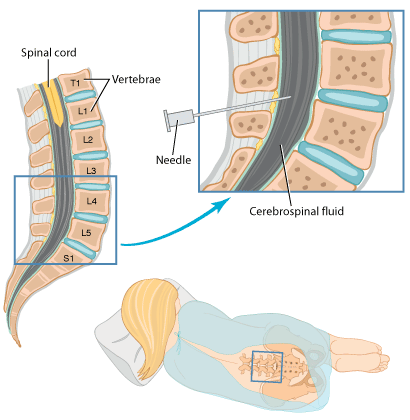Lumbar Puncture (Spinal Tap)
Article Translations: (Spanish)
What It Is
A lumbar puncture (LP), often called a spinal tap, is a common medical test that involves taking a small sample of cerebrospinal fluid (CSF) for examination. CSF is a clear, colorless liquid that delivers nutrients and "cushions" the brain and spinal cord, or central nervous system.
In a lumbar puncture, a needle is carefully inserted into the lower spine to collect the CSF sample.
Why It's Done
Medical personnel perform lumbar punctures and test the CSF to detect or rule out suspected diseases or conditions through analysis of the white blood cell count, glucose levels, protein, and bacteria.
Special testing can look for certain bacteria and viruses, or find the presence of abnormal cells that can help identify specific diseases in the central nervous system.
Most LPs are done to test for meningitis, but they also can detect bleeding in the brain and certain conditions affecting the nervous system (such as Guillain-Barré syndrome and multiple sclerosis). LPs also can deliver chemotherapeutic medications.
Preparation
After the procedure is explained to you, you'll be asked to sign an informed consent form — this document states that you give permission for the procedure to be performed and that you understand the procedure, why it is being done, and any potential risks.
The doctor performing the lumbar puncture will know your child's medical history, but might ask additional questions such as whether your child is allergic to any medicines.
You might be able to stay in the room with your child during the procedure, or you can step outside to a waiting area.
The Procedure
An LP takes about 30 minutes. The doctor carefully inserts a thin needle below the spinal cord — between the bones of the lower spine (vertebrae) — to withdraw the fluid sample.
The patient is positioned with the back curved out, so the spaces between the vertebrae are as wide as possible. This makes it easier for the doctor to insert the needle.
Older kids might be asked to either sit on an exam table while leaning over with their head on a pillow or lie on their side. Infants and younger children are usually positioned on their sides with their knees under their chin.

Once the child in the correct position, the back is cleansed with an antiseptic and a sterile area is maintained to minimize infection risk. The doctor performing the procedure also wears sterile gloves while performing the procedure.
A small puncture through the skin on the lower back is made and liquid anesthetic medicine is injected into the tissues beneath the skin to prevent pain. In many cases, before the injected anesthesia medication is given, a numbing cream is applied to the skin to minimize discomfort.
The spinal needle is thin and the length varies according to the size of the patient. It has a hollow core, and inside the hollow core is a "stylet," another type of thin needle that acts kind of like a plug. When the spinal needle is inserted into the lower lumbar area, the stylet is carefully removed, which allows the cerebrospinal fluid to drip out into the collection tubes.
After the CSF sample is collected (this usually takes about 2-5 minutes), the needle is withdrawn and a small bandage is placed on the site. Collected samples are sent to a lab for analysis and testing.
Sometimes doctors also measure the amount of pressure in the CSF using a special device called a manometer. High CSF pressure can happen under certain conditions, like meningitis.
What to Expect
While some notice a brief pinch and some discomfort, most people don't consider a lumbar puncture to be painful. Depending on the doctor's recommendations, your child might have to lie on his or her back for a few hours after the procedure. Your child might feel tired and have a mild backache the day after the procedure.
Getting the Results
Some results from a lumbar puncture are available within 45 to 60 minutes. However, to look for specific bacteria growing in the sample, a bacterial culture is sent to the lab and these results are usually available in 48 hours. If it's determined there might be an infection, the doctor will start antibiotic treatment while waiting for the results of the culture.
Risks
A lumbar puncture is considered a safe procedure with minimal risks. Most of the time, there are no complications. In some instances, a patient may get a headache. It's recommended that patients lie down for a few hours after the test and drink plenty of fluids to help prevent headaches, which usually resolve with rest, pain medications, and fluids. In rare cases, infection or bleeding can occur.
Sometimes, sedation medication may be helpful for your child in order to perform the procedure. If sedation is necessary, be sure to discuss the risks and benefits with your doctor.
Helping Your Child
You can help prepare your child for a lumbar puncture by explaining that while the test might be uncomfortable, it shouldn't be painful and won't take long. Also explain the importance of lying still during the test, and let your child know that a nurse might hold him or her in place. After the procedure, make sure your child rests and follow any other instructions the doctor gives you.
If You Have Questions
It's important to understand any procedure your child undergoes. If you have questions or concerns about the lumbar puncture procedure, be sure to speak with your doctor.
Note: All information is for educational purposes only. For specific medical advice, diagnoses, and treatment, consult your doctor.
© 1995-2024 KidsHealth ® All rights reserved. Images provided by iStock, Getty Images, Corbis, Veer, Science Photo Library, Science Source Images, Shutterstock, and Clipart.com

